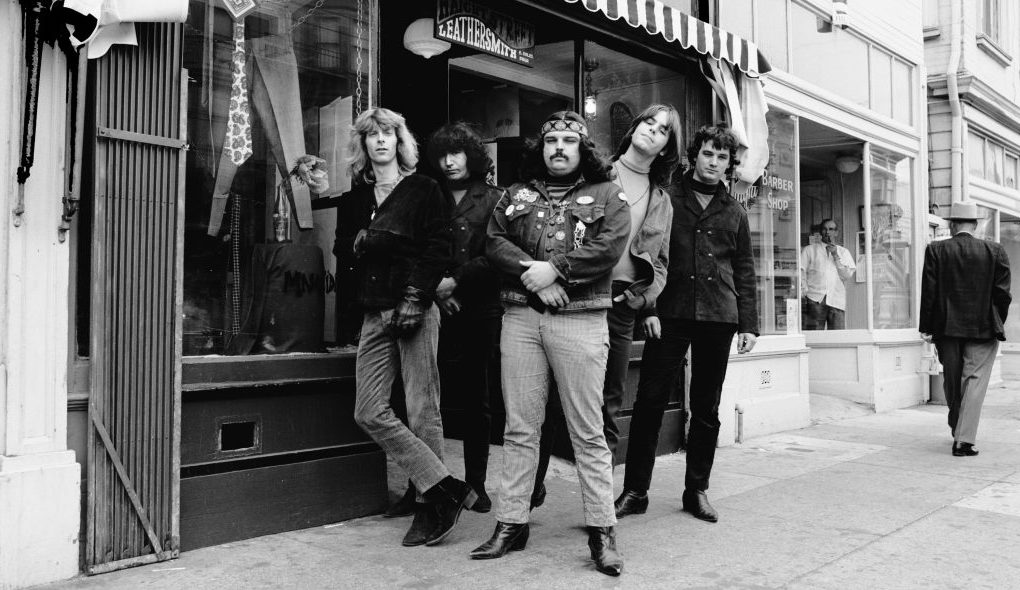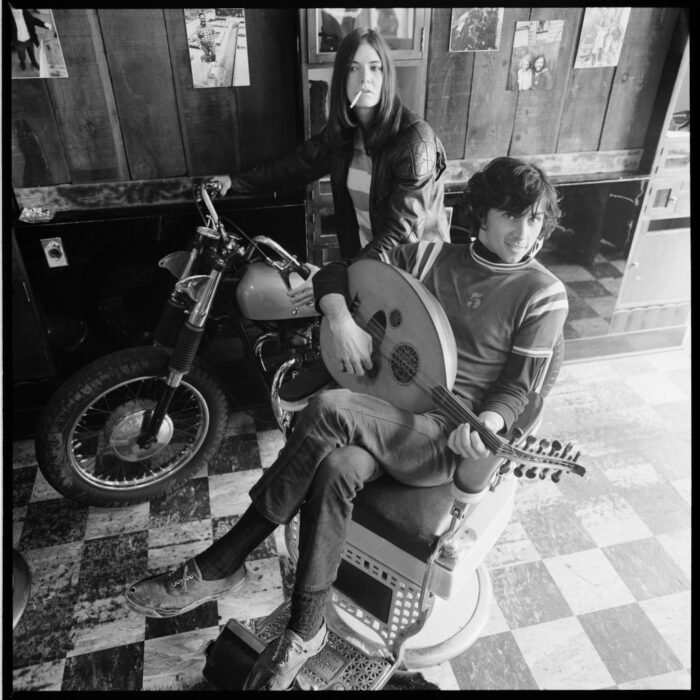Peggy Caserta arrived in San Francisco from Louisiana in the mid-1960s with a mixture of restlessness and an eye for clothes, and by opening the boutique Mnasidika on Haight Street she inserted herself into a small set of people who converted local styles into wider trends. Born in 1940 and later a public figure in accounts of San Francisco’s countercultural quarter, her life has been written about in obituaries and profiles that line up the basic biographical facts — her move from work at Delta Airlines to running a shop at 1510 Haight, her long friendship and romantic relationship with Janis Joplin, her later struggles with addiction, the two memoirs she published and the fact of her death in late 2024 — all of which frame a life that threaded commerce, scene life and caregiving in ways that make the Haight story legible.
The boutique she opened in April 1965 was small, billed at first as an inexpensive storefront around the Doolan-Larson building, but it quickly developed the pattern that would knot place and style together: a physical window and counter where musicians, road crews, poster artists and local scenesters met, where concert tickets and posters were circulated, and where improvised clothing changes could be purchased or commissioned. Contemporary chroniclers and preservation accounts point to 1510 Haight as the precise address and to Herb Greene’s photography and other documentary images as the primary visual evidence that the shop had, in a very short time, become part of the street’s public identity.
 |
| Peggy Caserta with her lover Janis Joplin. |
The choice of the name Mnasidika was not accidental; Caserta and those around her referenced queer literary echoes and small-circle codes that made the shop more than a commercial point of sale. Scholars of Haight culture and community historians have argued that that naming practice signalled a queer-friendly, woman-run space at a moment when such spaces were scarce, which meant the boutique served as both sartorial vendor and an implicit social site for non-normative identities. That coded quality matters because it helps explain why women and queer people found the shop welcoming, and why musicians and scene people felt free to hang out there as much as buy garments.
When Peggy Caserta opened her boutique at 1510 Haight Street in San Francisco's Haight-Ashbury district in 1965, she chose a name that resonated with both historical and personal significance. The name "Mnasidika" is derived from the character Mnasidika in the ancient Greek poem The Songs of Bilitis, a collection of lesbian poetry attributed to the Greek poet Sappho. This choice was not merely an aesthetic decision but a deliberate act of reclaiming and celebrating queer identity during a time when such expressions were often marginalized.
What actually happened inside those four walls is crucial to the story that follows: customers wanted a wider leg to their denim so boots would fit and movement would look better on stage and on the street. Local seamstresses — originally Caserta’s mother among them and then others in the Haight network — began manually splitting seams and inserting triangular panels of paisley or denim to create a flared silhouette. Those do-it-yourself modifications were the practical seed of what would be called bell-bottoms: garments altered in a workshop, offered for sale in a shop window, tried on by touring and local musicians, and photographed at their haunts.
 |
| Grateful Dead in the storefront of Peggy's Mnasidika. |
When demand for those modified Levi’s outstripped what one seamstress could produce by hand, Caserta famously took the matter to the factory. Her account — told in interviews she gave later and quoted by company historians — describes a visit to a local Levi Strauss location, a sympathetic older employee who remembered Levi Strauss himself, and an initial small run of flared jeans made on credit so the shop could sell an exclusive line for roughly six months. That hand-to-factory bridge is where the story moves from boutique anecdote to industrial replication: Levi’s went on to issue styles like the 646 Bell Bottom in 1969, and corporate histories now trace that model line back to the Haight’s demand for a flare that would fit the new dress code of stage and street.
The social side of the shop — musicians walking in, crews loitering, the sale of posters and the general interchange of tastes — was essential to the diffusion vector that made a local hack into a visible trend. Bands such as Grateful Dead and performers in Jimi Hendrix’s circle were photographed in front of the boutique, and stage visibility from such groups made the silhouette more legible to magazine editors and fashion photographers; those images were then reproduced and circulated. The shop’s function as a hub also included less formal commerce: word-of-mouth introductions, ticket distribution and an atmosphere in which styles were tried on and broadcast from the stage back into the street. The store’s role, therefore, was not only retail but social throughput — a place where fashion, friendship and scene logistics met organically.
The presence of Janis Joplin in that story accelerated visibility. Caserta’s accounts, and multiple profiles that draw on her memoirs and interviews, place Joplin at Mnasidika as a customer and friend at a point when the singer could not always afford new clothes; Caserta has described the exchange in casual terms that underline how small, local gestures fed into larger public moments. “We joked that we met over a pair of Levi’s,” Caserta said in an interview. Caserta’s closeness to Joplin — friendship, love and public association — meant the garments she sold were onstage and backstage at high-profile shows, and that in turn multiplied their visibility beyond Haight Street.
Addiction and later recovery appear as recurring elements in Caserta’s life story, reported by multiple outlets and discussed in her later interviews. Her path includes prison time, arrests in various jurisdictions and, eventually, a turn toward recovery and caregiving: she spent years looking after her mother and later moved away from San Francisco. Those human elements have been foregrounded in obituaries and recollections in a way that treats the Haight era as a complicated human history of risk, care and reinvention rather than a simple heroic chronicle.
The bell-leg silhouette itself did not end with the 1970s; it has recurred in fashion cycles in recent decades and continues to be reworked on runways and in street wear. Company retrospectives and fashion reporting note periodic revivals and reinterpretations, which demonstrates the style’s ongoing commercial plausibility; what began as a Haight street modification now participates in recurrent design cycles that reach a global consumer base.
The bellbottom style resurfaced with distinct shapes in later decades: in the 1990s, rave culture embraced oversized phat pants from brands like JNCO and Kikwear, engineered with wide hems and cargo-scale pockets that suited marathon dance sessions and stood out in strobe-lit spaces. During the early 2000s, the Y2K pop mainstream reintroduced low-rise flares through celebrity wardrobes and music videos, a return amplified by resale markets and fast-fashion copies. In each wave, the cut was altered — from denim bells to rave-ready extremes, then to tailored pop silhouettes — showing how the garment adapted to new demands rather than simply repeating past forms.
Later revivals highlight the style’s versatility within specific subcultures. Psytrance and Goa scenes throughout the 1990s and 2000s retained flared trousers for their functionality at outdoor festivals, while European techno hubs, especially Berlin, often steered in the opposite direction toward dark, narrow fits. By the 2010s and 2020s, high-fashion runways, resale platforms, and celebrity performances revived flares again, producing modernized designs with reinforced hems, stretch fabrics, and adjusted rises to balance practicality with editorial appeal.
You might also like the article I wrote about "Haight-Ashbury in the 1960s - The Epicenter of the Hippie Movement".
Sources:
- https://people.com/janis-joplin-former-lover-peggy-caserta-dead-age-84-8752866
- https://en.wikipedia.org/wiki/Peggy_Caserta
- https://www.sfheritage.org/heritage-in-the-neighborhoods/haight-street-turns-on/
- https://savingplaces.org/places/haight-ashbury
- https://www.fugues.com/2020/10/01/the-redemption-of-peggy-caserta/
- https://www.levistrauss.com/2019/11/22/how-haight-st-hippie-style-became-a-levis-sensation/
- https://www.levi.com/US/en_US/blog/article/the-it-jeans-of-the-1960s
- https://www.kqed.org/news/11748384/corner-of-haight-and-ashbury-in-san-francisco-declared-national-treasure
- https://howardlovy.com/peggy-caserta/
- https://www.sfgate.com/local/article/peggy-caserta-obituary-sf-bell-bottom-jeans-19976707.php
- https://www.thetimes.co.uk/article/herb-greene-obituary-photographer-at-the-heart-of-haight-ashbury-q7b3dqq3c
- https://www.fitnyc.edu/museum/exhibitions/denim.php
- https://scholarworks.iu.edu/journals/index.php/grj/article/view/41711
- https://haenfler.sites.grinnell.edu/subcultural-theory-and-theorists/commodification/
- https://www.levistrauss.com/2019/08/08/peace-love-bell-bottoms-celebrating-50-years-of-an-iconic-style/
- https://www.vulture.com/2018/08/peggy-caserta-janis-joplins-love-comes-clean-for-real.html
- https://www.youtube.com/watch?v=yHzA4X3z4lQ
- https://www.waudsfuneralhome.com/obituaries/Peggy-Caserta
- https://www.wsj.com/style/fashion/peggy-caserta-hippie-fashion-dies-at-84-f3cc9967
- https://default.sfplanning.org/Preservation/lgbt_HCS/LGBTQ_HCS_October2015.pdf
- https://digitalstories.famsf.org/summer-of-love/
- https://www.heddels.com/2019/03/fade-friday-levis-646-50-years-unknown-washes/
- https://www.steelzipper.com/steel_zipper_vintage_Levi_646_bell_bottoms.html
- https://haightstreetvoice.com/performance-art-comes-to-the-haight/
- https://m.facebook.com/SFHeritage/photos/herb-greene-photo-print-of-peggy-caserta-inside-mnasidika-in-1967-located-inside/5045311815546982/
- https://savingplaces.org/places/haight-ashbury/updates/launching-a-national-treasure-haight-and-ashbury
- https://uregina.scholaris.ca/bitstreams/b5e5a2b9-d4f0-49f3-aa04-9cfd4712c9b5/download
- https://medium.com/the-establishment/for-whom-the-bells-toll-the-life-and-politics-of-bell-bottoms-48b6014cd21
- https://www.ebar.com/story/58632
- https://fashionunited.com/news/fashion/the-bell-bottoms-from-the-runway-to-the-high-street/2021093042469
- https://www.vogue.com/article/victoria-beckham-bellbottom-flare-jeans




%20Songwriter%20Folk.jpg)
No comments:
Post a Comment
Note: Only a member of this blog may post a comment.